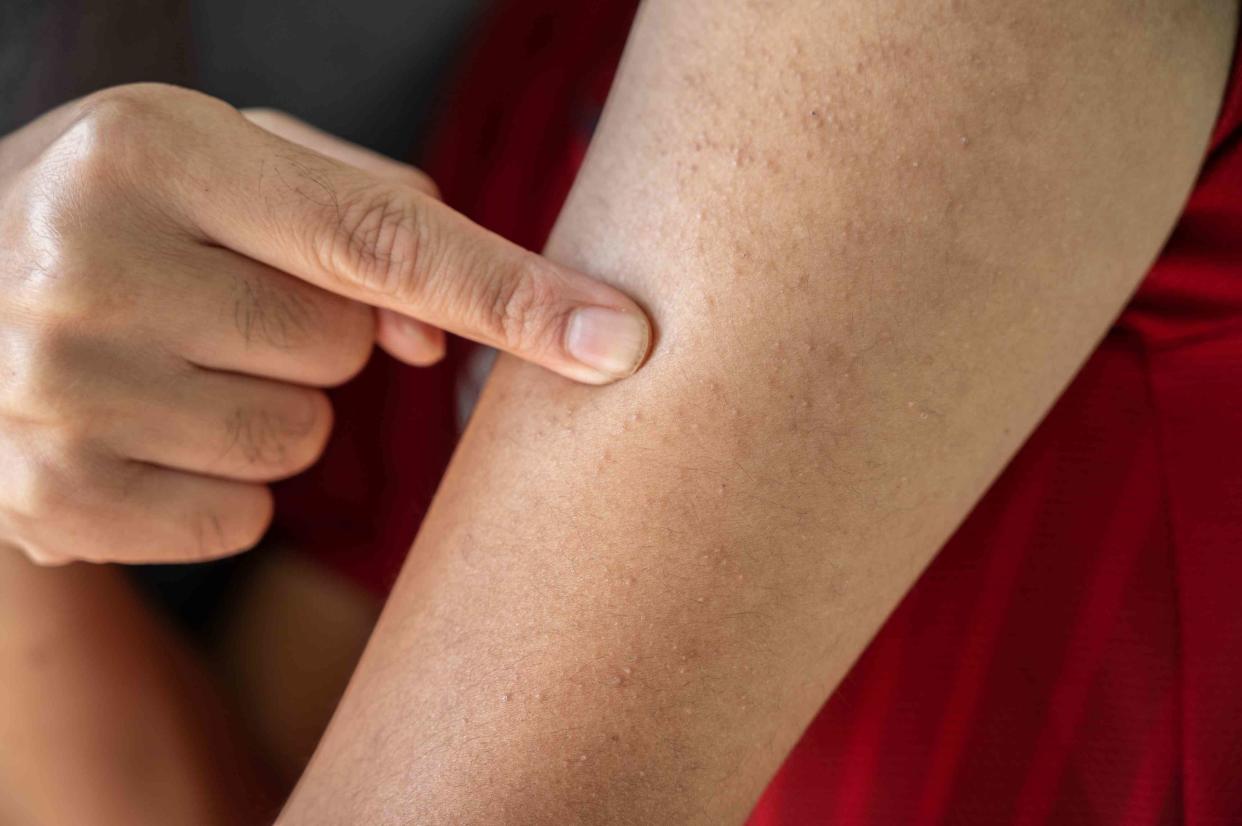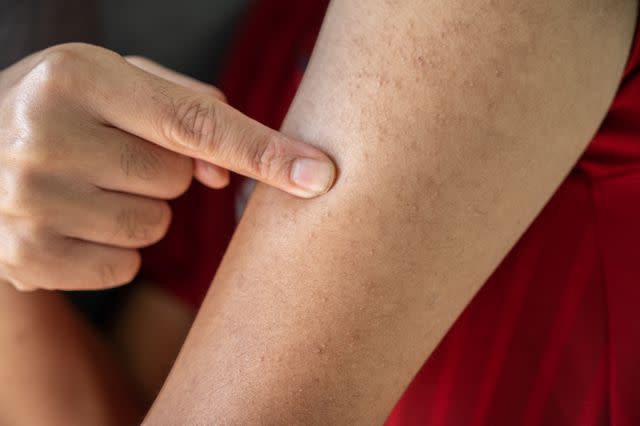Bumps on Skin

Boy_Anupong / Getty Images
Bumps on the skin refer to any abnormal raised areas, including lumps and swelling.
Most skin bumps are benign (noncancerous) and not a cause for concern. Some are temporary and will go away on their own, while others are permanent but harmless. In rare cases, bumps on the skin can be a sign of an underlying health condition, such as infection or skin cancer.
This article will go over the most common types of bumps on the skin, as well as treatment options and when to see a healthcare provider.

Boy_Anupong / Getty Images
Symptoms of Bumps on Skin
Bumps on the skin vary widely in texture, appearance, color, shape, and size. Depending on what’s causing the bump, it may appear either on the surface of your skin or under it. You may be able to feel the lump by touch or roll it around between your fingers. Some bumps are filled with fluid or pus.
In some cases, skin bumps are accompanied by other symptoms, such as redness, or swelling. They may be either painless or tender to the touch.
Some bumps on the skin are always visible, while others may appear suddenly (i.e., in a matter of hours or days). Many skin bumps are always the same size; others get bigger over time.
Causes of Bumps on Skin
Bumps can appear on the skin for many reasons. Common causes include:
Acne: Also called pimples, acne is caused by clogged pores and can include blackheads, whiteheads, papules, and cysts.
Warts: Often appearing on the hands and feet, warts are small, hard lumps caused by the human papillomavirus (HPV).
Calluses: Calluses or corns are rough areas of thickened skin. They often appear on the feet and toes due to irritation and pressure (such as from ill-fitting shoes).
Lipomas: Lipomas are benign fatty tumors that develop just under the skin. They are soft and movable.
Cysts: Cysts are usually benign sac-shaped pockets of tissue that are full of pus, air, or fluid that can appear anywhere on the body.
Boils: Usually caused by infected hair follicles, boils are tender bumps that fill with pus.
Moles: Moles are flat or slightly raised bumps that can appear anywhere on the body. They are often brown or tan, but they can also be black, blue, pink, red, or the same color as your skin.
Hives: Hives, or urticaria, are small, raised bumps on the skin that develop in response to an allergic reaction. They’re usually extremely itchy.
Molluscum contagiosum: Especially common among young children, molluscum contagiosum is a skin condition caused by a virus. Small, firm, skin-colored bumps appear in patches, usually for months at a time.
Keratosis pilaris: People with keratosis pilaris have many rough, dry bumps concentrated in certain areas of the skin, especially the thighs and upper arms. Children and teens are more likely to develop this condition than are adults.
Skin tags: Skin tags, or acrochordons, are small egg-shaped growths attached to the skin by a small “stalk.” They can grow anywhere on the body, but they often appear in the armpits, groin, or neck area.
Less commonly, bumps on the skin may be caused by bacterial or viral infections. For example, methicillin-resistant Staphylococcus aureus (MRSA) infections, also known as staph infections, are caused by antibiotic-resistant bacteria. MRSA skin infections cause fever as well as a painful, hot, pus-filled bump on the skin.
Chickenpox, which causes an itchy rash of small blisters, is also a viral infection. Anyone who gets chickenpox is also at risk of getting shingles, or herpes zoster (HZ). Shingles is a painful, localized blistering skin rash caused by the varicella-zoster virus (VZV), which also causes chickenpox.
Very rarely, skin bumps are caused by skin cancer or a precancerous skin condition, such as melanoma, basal cell carcinoma, actinic keratosis, or squamous cell carcinoma.
Signs of skin cancer include:
Moles that look irregular or have changed over time
Sores that don’t heal or keep coming back
Scaly patches
Skin spots that bleed, itch, or look different from others
Dome-shaped moles
How to Treat Bumps on Skin
Many common skin bumps are harmless and don’t require any treatment.
However, you may want to treat certain kinds of skin irregularities, such as acne, for aesthetic reasons or comfort. A board-certified dermatologist can help to prescribe medication to clear up your acne if over-the-counter (OTC) solutions, like products containing benzoyl peroxide or salicylic acid, don’t work.
Meanwhile, a dermatologic surgeon can remove certain benign bumps—such as lipomas, skin tags, warts, and moles—if preferred.
Antibiotics can be prescribed to treat bumps on the skin caused by an infection, such as a staph infection. Antihistamines are used to treat hives caused by allergic reactions.
The usual treatment for skin cancer is surgery. For certain types of skin cancer, cryotherapy (freezing off the affected area of skin), radiation therapy, or chemotherapy may help.
Are There Tests to Diagnose the Cause of Bumps on Skin?
In many cases, you’ll be able to determine the cause of a bump on your skin on your own. If you can’t figure it out, a dermatologist can often diagnose you from a visual examination.
If an infection or skin cancer is suspected, your healthcare provider may need to perform imaging tests or a biopsy. In a biopsy, a sample of your skin cells will be removed and sent off to a lab for further testing.
When to See a Healthcare Provider
In most cases, you can address common bumps on the skin by taking self-care measures at home. A dermatologist can help to treat common skin issues like acne and warts.
Let your healthcare provider know if you notice any changes in your skin, including new bumps or bumps that have gotten bigger over time. In some cases, this may be a sign of skin cancer.
You should also seek medical help if you think your skin bumps may be related to an infection. These bumps may be swollen, painful, red, and/or hot to the touch. They tend to develop within 24 to 48 hours.
Finally, get emergency medical help right away if your hives are accompanied by other signs of anaphylaxis (a severe allergic reaction), such as:
Difficulty breathing
Swollen tongue, eyes, face, or lips
Light-headedness
Chest pain
Difficulty swallowing or speaking clearly
Heart palpitations
Summary
Many different kinds of bumps can appear on the skin, such as acne, warts, calluses, moles, lipomas, skin tags, boils, and hives. Other reasons for skin bumps may include molluscum contagiosum, keratosis pilaris, and bacterial and viral infections. Rarely, skin bumps may be precancerous or cancerous.
Most of the time, bumps on the skin are no cause for concern and can be treated at home. Let your dermatologist know if you notice any new bumps or bumps that have changed in shape or size. Antibiotics can treat any bumps related to infections, while surgery is usually recommended in the case of skin cancer.

